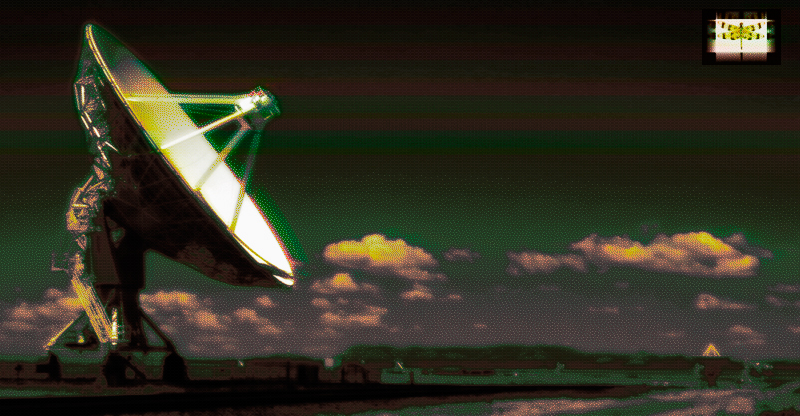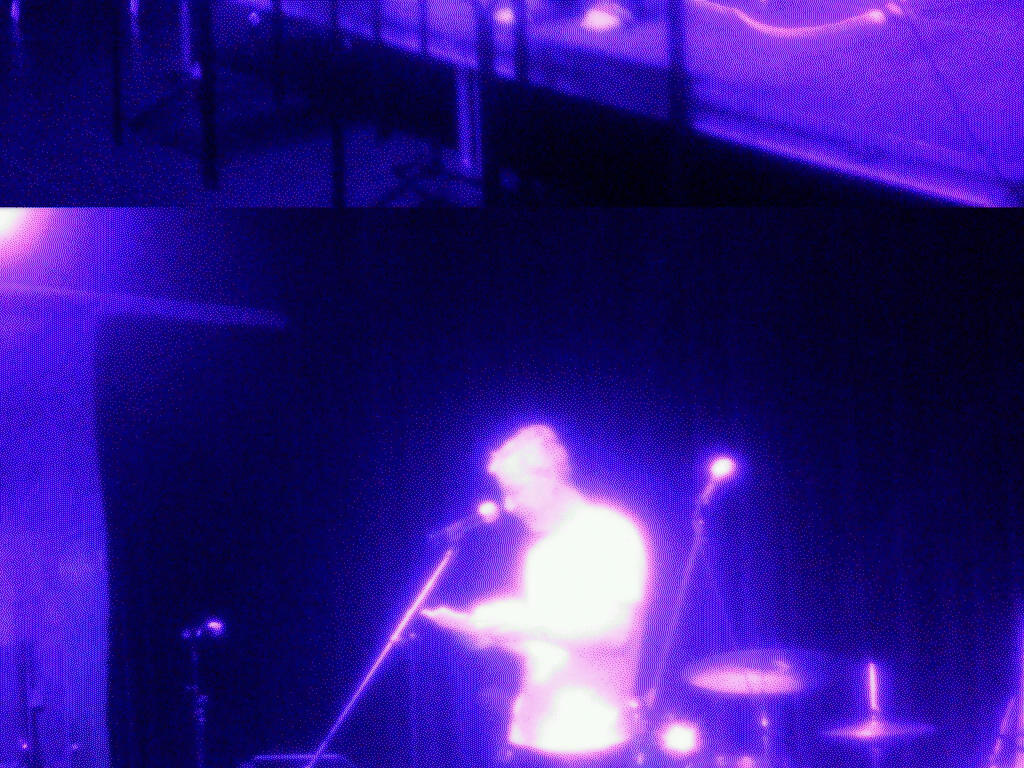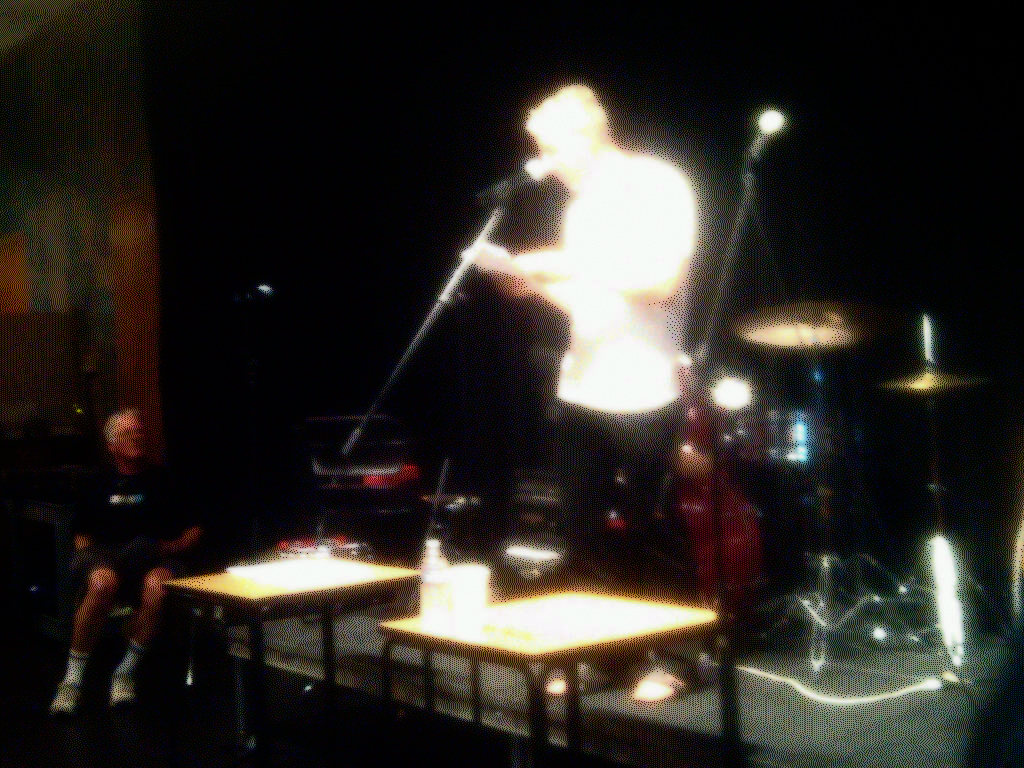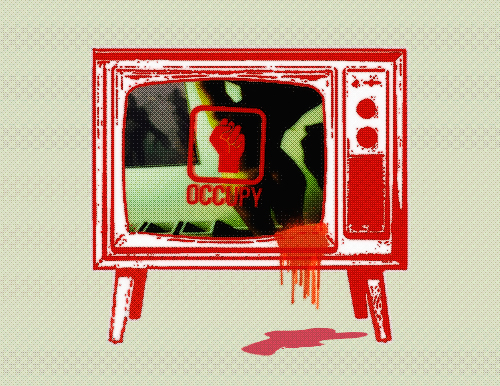 Eric Leiser [OAS Node 1 @Bat Haus, August 17, 2012 (Photo by Paul McLean)]
Eric Leiser [OAS Node 1 @Bat Haus, August 17, 2012 (Photo by Paul McLean)]
"Holography: Merging the Real and Virtual for the 21st Century"
Eric Leiser, Occupational Art School, Aug. 17
By Christopher Moylan
So much of the art that draws large crowds to museums and galleries is of the sort that demonstrates a breakthrough in the understanding of human perception. Egyptian art in its various stages, Early Renaissance painting, Impressionism, Pointillism, and Cubism, as well as early photography and film combine the intrinsic appeal of the image with a more abstract, historical interest in how the image was made and what this process says about the ways in which people experience the world.
Of course, the works that are so widely appreciated are not simply technical demonstrations or curiosities. There is something transcendent and simply perfect in Piero della Francesca’s “The Flagellation of Christ,” as there is in Seurat’s “The Bathers at Arsnieres”, Monet’s Haystacks, and so on. Every period in art history has its corresponding high points, and it could be argued that any serious work of art, in any medium, reveals something about the workings of human perception. Nonetheless, certain changes in art practice are striking and remain so through time. The development of linear perspective in the early Renaissance represents a fundamental change in the understanding of the picture plane, and of how the eye constructs meaning out of environmental information. Anyone can see this, and anyone looking at one of Piero’s paintings can take part, intuitively and vicariously, in the pleasure of this breakthrough.
When a person who has little or no academic background in art history volunteers that Impressionism is his favorite kind of art, this is not a cliché, at least not for him or her. It’s a statement of affiliation to something powerful and continuously new; this is beautiful and interesting, and I don’t care what you say, I like it. High Modernism may be the last period in art history to be widely associated with this kind of perceptual advance. (There may be others; Clement Greenberg and Walter Gombrich can sort out what and when.) No doubt not many in the huge crowds that line up for a large scale exhibition of Picasso’s work might have some difficulty discussing the importance of duration, multiple perspective and geometric configuration in his Cubist phase, but they know something of all that and they find it fascinating.
So after Impressionism, Pointillism, Cubism, what next?
Holography, perhaps.
This may seem unlikely; holography is most often seen in science fiction movies, and even that context it’s a novelty or gimmick. Eric Leiser, speaking at Occupational Art School, had little patience with that view of the technology. A filmmaker and pioneer in holographic technology, he is developing holography as an art form and in the process investigating the metaphysical properties of light as material information. A talk which was originally planned as a demonstration and lesson in basic holographic process, along with a sample of Leiser’s holographic images, quickly turned into something spiritual and yet utterly practical.
A holographic image, he explained, is not merely a technical process, splitting a laser beam against mirrors so that the light drapes the surface of the object while another beam strikes the emulsion. It is a thing, a material form of light as information. This thingness is in some processes directly apparent. With haptic holography, for instance, the projected energy is so dense that one can touch it. For that matter, one can construct a building with haptic holography, or a bridge, a structure that can be just as useful as something made of brick or wood but with the advantage that it will vanish when the object is no longer needed, leaving no trace on the site where it stood. Haptic or cymatic holography uses ultrasonic waves to give density, tactile resistance, and thingness to a holographic image.
All of these processes dissolve the constructs that delineate experience, impose boundaries and markers—me-you, this-that, signifier-signified—that are purely expedients of our cognitive makeup. We anthropomorphize the signified, make sense of it with the thinking, experiencing equipment we have—eyes, nerves, brain and so on. The usual separation of inert and living objects begins to dissolve in holography. The holographic image reveals that every object is constituted with energy in different configurations and this energy is interactive—dynamic. The rock doesn’t just sit there, no more than the person does. It acts, and in a sense, speaks. The hologram captures this speech within the spooky quantum physics of light waves.
In quantum physics information is reality or, as Rob Braynton puts it, “our reality is just an expression of the information encoded within the underlying fabric of quantum fields” (“Imagining the Tenth Dimension” blogspot). A great deal of research, distilled to an evocative phrase, has it that this universe is a hologram of a fifth dimension. The holographic images Eric Leiser makes in his studio offer glimpses of this quantum reality. The holograph is not an image of the subject, it is the real of the subject.
The real, in this way of thinking, is a far cry from the horrific fissure in the signifying system that it is made out to be by Lacan, Zizek and their followers. For Zizek, the thinged word is Das Ding, a monstrous something that appears in a crack in the signifying system, an impossible glimpse at noumenal reality. In this view, the signified and signifier cannot meet; we shouldn’t be able to bite into the word apple. For Leiser, the real is not threatening at all. It is fascinating, approachable and often quite beautiful. With lasers costing only a few dollars, it is also affordable; almost anybody can make one.
But, if I have it right, this is almost like saying a prayer is free, anybody can say one. There is more to it than that.
The art of holography, as Eric presented it, seemed the art of spiritual reflexivity. A way of thinking of the soul in his view, for example, is to think of a hologram making a hologram of itself. Similarly, we can think of the brain not as an organic system encased in a hard shell, but as a star system with its own pulsars and black holes, its vast array of energy transfers and informational novae where holographic interference patterns establish themselves in dimensions that it hurts the ordinary brain to consider. Everything, everywhere we look is multivalent, dynamic and endlessly possible. Our idea of energy as such need not be restricted to oil and gas and nuclear; a room is filled with endless energy, should we choose to access it—and, according to Mr. Leiser, the time when we will do so isn’t that far off.
To return to art in its usual sense; there were pictures, lovely pictures projected on the wall of Bat Haus. One could tilt the ipod from which an image was projected and the image would morph. The possibilities for abstraction—a kind of abstraction in physics—are just beginning to be explored, as is the relation of holography to traditional media. Eric has experimented with projecting holographic images on painted canvases; the possibilities along those line are intriguing. The development of three dimensional printing opens new possibilities for the book, for sculpture and so on. The necessary condition for such possibilities to be realized, however, is that holography be situated within art practice and discourse.
Eric is remarkably well placed to do just that. A graduate of CalArts with an extensive technical background, he is the founding member of Albino Fawn Productions along with his brother, composer Jeffrey Leiser. He has exhibited widely in the U.S. and around the world. His work has appeared in major museums and art festivals. The films he and his brother have produced are widely distributed. He was about to depart for a film festival in Hiroshima at the time of his talk, and his work was on exhibit at "Hologalactic" at All Things Project at The People's Church of Greenwich Village (curated by Sam Kho and Susan Joyce of Fringe Exhibitions) He is extremely productive.
It is unlikely, however, that Eric thinks much about career, or money or even little things like dinner or sleep. He strikes me, anyway, as someone completely liberated by work. It is appropriate for him to appear in an Occupy or Occupational space because he is so liberated and so generous; I imagine that if the fellow selling him a hot dog or cup of coffee asked about holograms that Eric would sketch it out for him, teach the basics of holographic technique on the spot and set him up with the url addresses of sites where he could pursue this further. One can quarrel with all of the metaphysical ideas Eric generates, if one choses, but the good news remains. He, and lots of the people, are at work outside the capitalist system of mega-profit and celebrity self-aggrandizement, busy transforming not only our understanding of perceptual systems in art, but our understanding of the human. The technology for unlimited energy supply may be a ways off, but the vision of separating energy from exploitation and violence is pertinent and necessary right now. Eric’s holistic view of the production and hermeneutics of art are as far removed from current discourse in the art world as can be.
I am beginning to think that the art world of the oligarchic collectors and fashionistas is tilting on a precipice of crazy economic conditions and general cultural indifference. Be that as it may, the kinds of technical, spiritual and artistic explorations Eric Leiser is pioneering matter now and no doubt will matter increasingly as time goes by; the crowds will line up sooner or later.
 Monday, September 24, 2012 at 10:33PM
Monday, September 24, 2012 at 10:33PM 
 admin
admin












